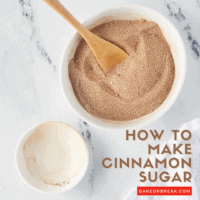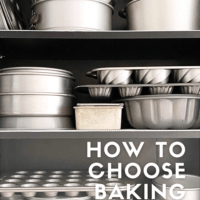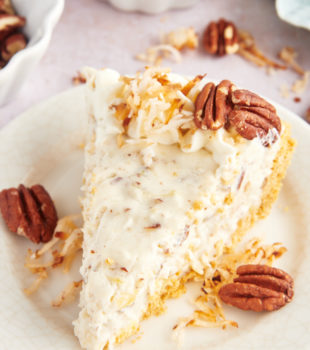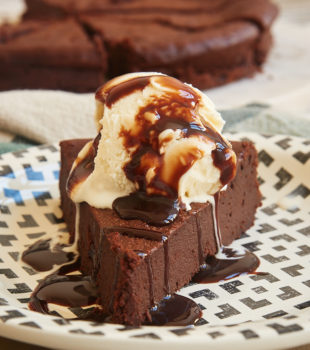If you’ve ever wondered about the differences between rolled oats and quick oats, then keep reading to find out what you need to know for baking with them. We’ll talk about their differences and the best ways to use them.

Table of contents
Rolled Oats vs Quick Oats in Baking
Oats are a popular baking ingredient, whether you’re baking a batch of oatmeal cookies or making a simple fruit crisp. The two types of oats most often used in baking are rolled oats and quick oats. While they’re quite similar, there are some differences that will come through when baking with them.

What Are Oats?
Let’s start simply with oats, which are a type of cereal grain. The whole oats are called oat groats. Both rolled oats and quick oats come from the same grain, but they are processed differently. If you’ve ever looked at these two types side by side, you can easily see the difference in the sizes of the pieces.

What Are Rolled Oats?
Rolled oats, also known as old-fashioned oats, are made by steaming and flattening whole oat grains. They have a chewy texture when raw, but soften when cooked or soaked. Rolled oats are commonly used in recipes for oatmeal cookies, quick breads, muffins, and other baked goods.
The larger size of these oats create a chewy texture when added to baked goods. The pieces of oats tend to keep their shape through baking, lending to that hearty texture.
Recipes Made with Rolled Oats

What Are Quick Oats?
Quick oats, also known as instant oats, are rolled oats that have been cut into smaller pieces and rolled even thinner so they cook faster. Because of their smaller size, quick-cooking oats are often used in recipes that might benefit from a less chewy texture.
They can be added to baked goods like cookies or muffins when you want the flavor and some of the texture of oats but a little less of that hearty chewiness usually associated with oats.
Although they are sometimes called instant oats, don’t confuse these with pre-cooked instant oats.
Recipes Made with Quick Oats

Substituting Types of Oats
Generally speaking, rolled oats and quick oats can be swapped for each other in most baking recipes. You can do this because of your own preferences or just when you find yourself without the kind you need. While the taste is largely unaffected, you can expect differences in the end result. There are just a few things to keep in mind when making a substitution.
- Measurements – I usually recommend making the substitution by volume instead of by weight. In my experience, a cup of one doesn’t quite weigh the same as a cup of the other. It may not make much of a difference in smaller amounts, but it’s good to keep in mind.
- Texture – You’ll get a chewier texture with rolled oats, and less chewiness with quick oats.
- Shape – These two types of oats don’t incorporate into a dough quite the same way. This is less relevant if you’re baking a cake or making a crisp topping, but you’ll often see a difference in overall shape and size when making cookies.
- Baking time – Because of the difference in their size, recipes made with rolled oats may take slightly longer to bake than those made with quick oats. This will vary depending on what you’re making and how much of an oat component is present. You may find that it doesn’t make a difference at all, but it is worth keeping in mind.



Cookies Made with Rolled and Quick Oats
To show you the differences you might see when swapping one type of oat for the other in baking, I made two batches of simple oatmeal cookies. One batch was made with rolled oats, while the other was made with quick oats. You can see above the differences in the dough and the cookies. While the flavor is largely unaffected by this change, the size, spread, and texture are all altered to some degree.
Other Types of Oats
Oat flour is made from ground rolled oats. While oat flour is usually gluten-free, it’s also used in combination with wheat flours. While you can purchase oat flour, making it yourself from rolled oats is a simple process. All you need to do is grind rolled oats in a food processor or blender until a fine powder is formed. You can see ground oats used this way in my Favorite Chocolate Chip Cookies.
Steel-cut oats, also known as Irish oats or Scottish oats, are made from whole oats that have been chopped into small pieces. They’re more coarsely ground than rolled or quick oats, and they take longer to cook and tend to retain their chewy texture and shape. Because of this, they aren’t frequently used in baking and shouldn’t be used as a substitute for rolled or quick oats.
More Baking Recipes with Oats
Ready to get baking with your new knowledge of rolled oats vs quick oats? Visit my recipe index to find lots of oats recipes, from cookies to muffins to cakes and a whole lot in between.
Frequently Asked Questions
Rolled oats are bigger and create a chewier, thicker result. Quick oats are smaller and create a finer texture. You should only see differences in texture and shape, not flavor.
In most cases, rolled oats and quick oats can be substituted for each other in baking recipes. Expect differences in texture and shape. Use the same volume when substituting.
You can usually make this substitution without any other changes, although the texture of the final result will be affected. You can also make a DIY version of quick oats by briefly pulsing rolled oats in a food processor to make them more like the size of quick oats.
The other characteristics of the cookies and your personal preferences usually determine which type of oats is preferred. You’ll get a more pronounced chewy texture with rolled oats than with quick oats.
Oats are naturally gluten-free, but they may come into contact with gluten-containing ingredients during processing. If you require a gluten-free diet, always check product labels for dietary information.














6 Comments on “Rolled Oats vs Quick Oats”
Thank you for this explanation. I make a lot of fruit crisps and recently encountered the differences in oats when I substituted rolled oats for the plain instant oats on one batch of topping. Oh my, what a difference. As you said the taste wasn’t affected, but the chewiness of oats in the topping was glaring. Fruit crisps don’t usually require a lot of chewing, but this did. Next time, I’ll go back to my old instant oats for my toppings.
I do like the steel cut oats for breakfast though.
I’m glad you found this helpful, Maxine! It can be surprising the difference the two kinds can make.
Thanks for this explanation. I found it very helpful. So if a recipe calls for 2 cups rolled oats, could I use 2 cups of instant oats, or should I increase the volume of instant oats?
I’m glad you found it helpful, Sarah! Yes, you can make that substitution. Just make sure the oats aren’t the pre-cooked kind.
Thank you for this excellent clear article about the complexities of baking with oats. I absolutely need to watch texture because I am making dog cookies and it has to be right. You have help me see why I’m getting variation and I now understand what to do. Beautiful, concise clear article.
Thanks, Jan! I’m glad you found it helpful!